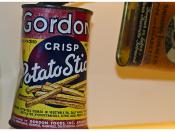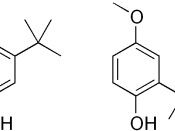Butylated hydroxyanisole (BHA) and the related compound butylated hydroxytoluene (BHT) are phenolic compounds that are often added to foods to preserve fats. BHA and BHT are antioxidants. Oxygen reacts preferentially with BHA or BHT rather than oxidizing fats or oils, thereby protecting them from spoilage. In addition to being oxidizable, BHA and BHT are fat-soluble. Both molecules are incompatible with ferric salts. In addition to preserving foods, BHA and BHT are also used to preserve fats and oils in cosmetics and pharmaceuticals.
BHA is generally used to keep fats from becoming rancid. It is also used as a yeast de-foaming agent. BHA is found in butter, meats, cereals, chewing gum, baked goods, snack foods, dehydrated potatoes, and beer. It is also found in animal feed, food packaging, cosmetics, rubber products, and petroleum products. BHT also prevents oxidative rancidity of fats. It is used to preserve food odor, color, and flavor.
Many packaging materials incorporate BHT. It is also added directly to shortening, cereals, and other foods containing fats and oils.
Both BHA and BHT have undergone the additive application and review process required by the US Food and Drug Administration. However, the same chemical properties which make BHA and BHT excellent preservatives may also be implicated in health effects. The oxidative characteristics and/or metabolites of BHA and BHT may contribute to carcinogenicity or tumorigenicity; however the same reactions may combat oxidative stress. There is evidence that certain persons may have difficulty metabolizing BHA and BHT, resulting in health and behavior changes. BHA and BHT may have antiviral and antimicrobial activities. Research is underway concerning the use of BHT in the treatment of herpes simplex and AIDS.





